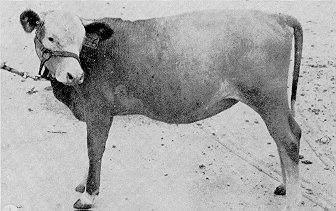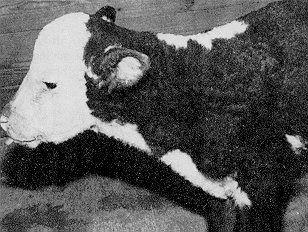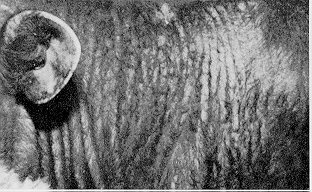Source: OMAFRA
Learn the causes of some genetic abnormalities in beef cattle and how to deal with them.
Introduction
Congenital defects can cause abortion or be present at time of birth. They are uncommon but do occur in most breeds of cattle. Defects are abnormalities in skeleton, body form, and body functions. Abnormalities may result from genetic or environmental causes. When the environment is the cause, adjustments can reduce further economic losses. However, genetic (inherited) causes are much more complex and difficult to correct.
Environmental Causes
Environmental or non-genetic causes have the same economic results as genetic causes but are far easier to rectify. Simply correcting the environment will remove the problem. There are many environmental factors, including disease and diet.
Certain conditions show that an abnormality is likely to be environmental in nature:
- The abnormality coincided with an environmental factor and was absent upon removal of the factor.
- The abnormality occurred in groups of non-related individuals.
- The symptoms are similar to those of an abnormality known to result from environmental factors.
Genetic Causes
Chromosomes inherited from parents determine an animal’s genetic make-up. There are many genes in each chromosome. Genetic abnormalities occur when genes are missing, in excess, mutated or in the wrong location (translocation). A few genes can directly cause an abnormality, however, these are rare. Usually, these genes are recessive, meaning two must be present to cause an abnormality. Both parents must be carriers of the gene for a calf to be abnormal. In this case, only one of every four offspring will be abnormal. Two will be carriers and one will be normal.
Certain conditions show that an abnormality is likely to have a genetic origin:
- The abnormality is more common in a group of related animals.
- The symptoms are similar to those of an abnormality identified through test matings. Study of an animal’s chromosomes using blood samples can identify several genetic defects.
Common Genetic Defects
Hypotrichosis (Hairlessness)
Hairlessness occurs in several breeds of beef cattle. It expresses itself as complete or partial loss of hair. Calves are often born with no hair but will grow a short curly coat of hair with age. Affected individuals are prone to environmental stress (cold and wet) and skin infections are more prevalent. A recessive gene causes hairlessness.
Figure 1. Partial Hypotrichosis.
Figure 2. Complete Hypotrichosis.
Alopecia Anemia
This syndrome has recently been identified in the Polled Hereford breed. At the time of birth, alopecia anaemia may be mistaken for hairlessness. Affected calves are often small at birth, have a dirty-faced appearance, and have protruding tongue and eyes. Hair is wiry, tightly curled or absent while wrinkled skin gives the appearance of advanced aging. Calves are lethargic, cannot tolerate stress and are very prone to disease. Few survive past six months of age. Malfunction of the skeletal structure results in reduced red blood cell production (anaemia). Alopecia anaemia occurs in families but the exact mode of transmission is unknown.
Figure 3. Three-day-old calf affected with congenital alopecia and anaemia. Note the appearance of the hair and skin and the dirty face and protruding tongue.
Figure 4. Six-month-old calf, neck and shoulder. There is marked wrinkling of the skin.
Translocations
A translocation occurs when part of a chromosome breaks off and attaches to another chromosome. The 1/29 translocation has been identified in the Simmental, Charolais and Blonde D’Aquitaine breeds. The 14/20 translocation occurs in most Continental breeds. Translocations affect fertility but no other production traits. Carriers of translocations have reduced conception rates and increased abortion rates. Blood analysis allows easy identification of carriers.
Beta-mannosidosis (Beta-man)
The Beta-man disorder is due to a recessive gene that produces a defective enzyme. The result is the birth of calves that never get up and eventually die. The syndrome occurs in the Salers breed and a blood test is available for identifying carriers.
Syndactyly (Mulefoot)
Syndactyly refers to the fusion of the two toes of the foot. Caused by a recessive gene, mulefoot most often affects the front feet. This condition occurs in the Aberdeen Angus breed.
Figure 5. Syndactyly and normal hooves.
Other genetic defects exist, most being of very low frequency.
What Should You Do?
When you suspect that you have a problem calf, consult your veterinarian and OMAFRA extension specialist. Investigate all symptoms and possible causes before concluding the problem is genetic or environmental. When the cause is genetic, contact the breed association and give them a full report of the findings. Progressive breed associations are working to reduce the frequency of genetic abnormalities within their breed.
To avoid further abnormalities in your herd without culling female carriers, use non-carrier bulls unrelated to your herd. Practice no inbreeding within the herd. Crossbreeding to a different breed is another alternative.
Summary
Genetic abnormalities are not common. When they do occur, they cause economic losses. Genetic and environmental factors cause abnormalities. Environmental causes are quickly corrected while genetic causes require longer term solutions. If an abnormality occurs on your farm, take immediate action.
Further Reading
- Congenital Anaemia, Dyskeratosis, and Progressive Alopecia in Polled Hereford Calves. Steffen, D.J. et al, 1991. Journal of Vet. Pathol. 28:234.
- Congenital Defects in Beef Cattle, Leipold, H.W. et al, Gelbvieh World. July-August 1987.
- Inherited Abnormalities in Cattle, Goonewardene, L., Alberta Beef Herd Management Reference Binder.
- Nature’s Costly Mishaps, Leipold, H.W., and Schelles, R.R., Beef. Spring 1992
- Occurrence of Hypotrichosis in Polled Hereford Cattle. Olson, T.A. et al, 1985. The Bovine Practitioner – No. 20.
- Tackling a Genetic Disorder Head-On. Larry Thomas, Cattlemen. June 1991.
- Translocation. Cunningham, B.E., Simmental Country. April 1991.














